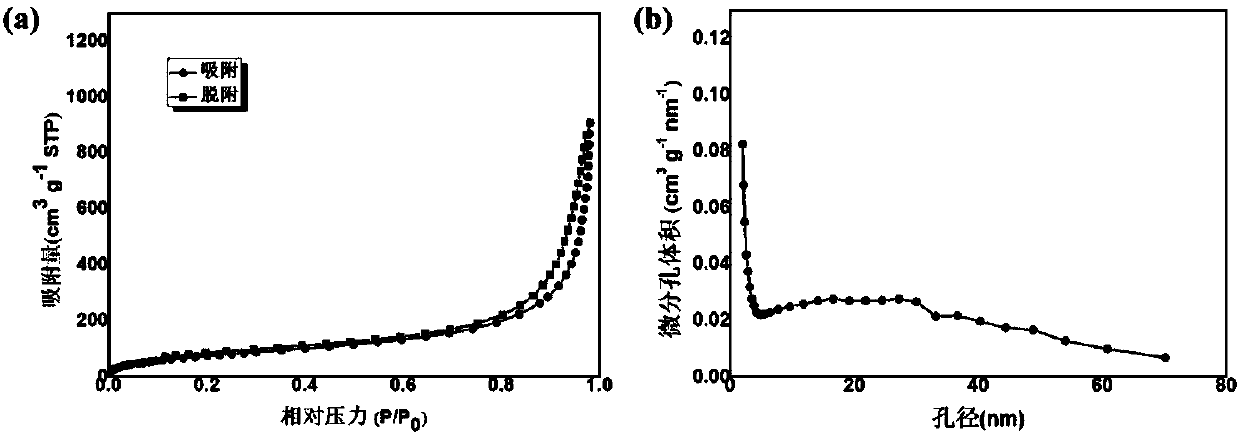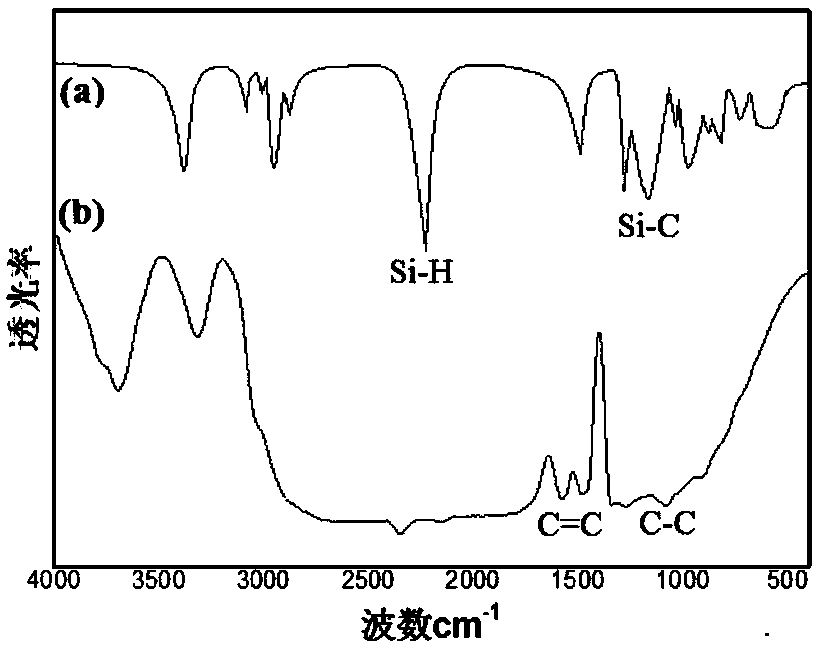Polysilazane-zirconium dioxide composite aerogel material as well as preparation method and application thereof
A technology of composite aerogel and polysilazane, which is applied in the production of bulk chemicals, etc., to achieve the effect of simple process, high porosity and low density
- Summary
- Abstract
- Description
- Claims
- Application Information
AI Technical Summary
Problems solved by technology
Method used
Image
Examples
Embodiment 1
[0032] Step (1) Disperse 0.40g polysilazane (PSN) precursor containing vinyl side chains and Si-H bonds with a number average molecular weight of 1000 in 0.40g toluene, and add 0.05g tetrabutyl zirconate (TBT ) and 0.50g divinylbenzene (DVB), stir rapidly, and then transfer the prepared mixed dilute solution to the polytetrafluoroethylene lining of the hydrothermal reaction kettle, and seal it; the reaction kettle filled with the mixed solution is placed React in a drying oven at 180°C for 3 hours. After cooling to room temperature, a wet gel is obtained. Add toluene into the beaker containing the wet gel to submerge the wet gel test piece, and let it stand for 24 hours before use.
[0033] Step (2) Transfer the product in step (1) to a carbon dioxide supercritical extraction device, immerse in liquid carbon dioxide for about 1 hour, and then perform supercritical drying at a drying temperature and pressure of 45° C. and 8 MPa, respectively, for 6 hours.
[0034] The specific ...
Embodiment 2
[0036] Step (1) disperse 0.40g polysilazane (PSN) precursor containing vinyl side chains and Si-H bonds with a number average molecular weight of 1000 in 0.40g toluene, and add 0.10g tetrabutyl zirconate (TBT ) and 0.60g divinylbenzene (DVB), stir rapidly, and then transfer the prepared mixed dilute solution to the polytetrafluoroethylene lining of the hydrothermal reaction kettle, and seal it; the reaction kettle filled with the mixed solution is placed React in a drying oven at 160°C for 6 hours. After cooling to room temperature, a wet gel is obtained. Add toluene into the beaker containing the wet gel to submerge the wet gel test piece, and let it stand for 36 hours before use.
[0037] Step (2) The product in step (1) was transferred to a carbon dioxide supercritical extraction device, immersed in liquid carbon dioxide for about 0.5h, and then supercritically dried at a drying temperature and pressure of 40°C and 9MPa for 7h.
[0038] The specific surface area, porosity a...
Embodiment 3
[0040] Step (1) disperse 0.40g polysilazane (PSN) precursor containing vinyl side chain and Si-H bond with number average molecular weight 1000 in 0.40g toluene, add 0.20g tetrabutyl zirconate (TBT ) and 0.80g divinylbenzene (DVB), stir rapidly, then transfer the prepared mixed dilute solution to the polytetrafluoroethylene lining of the hydrothermal reaction kettle, and seal it; the reaction kettle filled with the mixed solution is placed React in a drying oven at 200°C for 1 hour, and cool to room temperature to obtain a wet gel. Add toluene into the beaker containing the wet gel to submerge the wet gel test piece, and let it stand for 32 hours before use.
[0041] Step (2) Transfer the product in step (1) to a carbon dioxide supercritical extraction device, immerse in liquid carbon dioxide for about 2 hours, and then carry out supercritical drying at a drying temperature and pressure of 50° C. and 7 MPa for 8 hours.
[0042] The specific surface area, porosity and density o...
PUM
| Property | Measurement | Unit |
|---|---|---|
| Density | aaaaa | aaaaa |
| Specific surface area | aaaaa | aaaaa |
Abstract
Description
Claims
Application Information
 Login to View More
Login to View More - R&D
- Intellectual Property
- Life Sciences
- Materials
- Tech Scout
- Unparalleled Data Quality
- Higher Quality Content
- 60% Fewer Hallucinations
Browse by: Latest US Patents, China's latest patents, Technical Efficacy Thesaurus, Application Domain, Technology Topic, Popular Technical Reports.
© 2025 PatSnap. All rights reserved.Legal|Privacy policy|Modern Slavery Act Transparency Statement|Sitemap|About US| Contact US: help@patsnap.com



